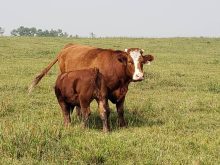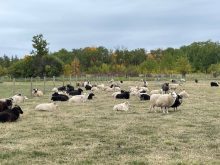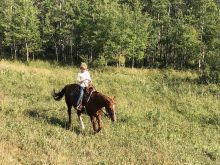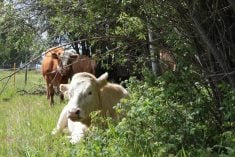While his B.C. Cariboo Region ranch may between six to eight hours drive from major population markets, Rainer Krumsiek hasn’t let distance get in the way of developing a successful pasture-raised and finished meat business.
Krumsiek, at Big Bear Ranch near Horsefly, (a small town in central B.C.) about 15 years ago started using Galloway bulls on Hereford-Angus cows to produce grass-fed beef.
Today he’s making regular delivery runs to Vancouver to the west and the Okanagan region to the south (and several points in between) to bring beef, pork and lamb to dozens of repeat customers.
Read Also

Harvest wraps up and fall work begins
At the Eppich famly ranch in western Saskatchewan, the fall harvest was successful with few breakdowns, cows and calves have been sorted and a new tractor has arrived
“We can finish cattle on grass in 24 to 30 months, partly due to the high plane of nutrition in our naturally grown forages, but also because of their genetics,” he says. “The combination of Galloway, Hereford and Angus makes for very efficient cows.”
The ranch has a growing customer base for beef, with more than 600 people on their email list. “In 2004 we started delivering house-to-house, and some of those customers are still with us,” says Krumsiek, who emigrated from Germany in 1993. “For the past 10 years, however, we’ve used designated meeting points where they pick up their order.”
In the beginning Krumsiek used a flat-deck trailer loaded with seven freezers. It was a challenge if it was raining in Vancouver when he arrived to deliver the meat. “We also needed 12 big freezers at home because we only went to Vancouver three to four times a year,” he says. He’s now switched to a cargo-style trailer, which holds five freezers powered by a generator.
Krumsiek now delivers to Vancouver every four weeks and has expanded sales into the Okanagan. This makes each trip about nine hours, but he has enough customers there to make it worth the extra distance. Meat from the ranch is delivered on a route that covers Williams Lake, Cache Creek, Kamloops, Vernon, Winfield, Kelowna, Merritt, Hope, Chilliwack, Abbotsford, Surrey, Burnaby, North Vancouver, Vancouver, Steveston and many other towns.
Lamb and pork too
Krumsiek also sells lamb and pork. The ranch raises heritage-breed pigs (Tamworth and Large English Black crosses) stay on pasture year-round except when farrowing. “I have a Tamworth boar and a Large English Black boar and two sows from each breed,” says Krumsiek. ”I produce F1 cross hogs, which are supposed to grow better and faster.”
The pigs live their entire lives free-ranging at pasture and are fed certified organic hog grower in addition to eating whatever they find while rooting. The pasture-raised lambs are produced from a cross of meat and hair-type sheep breeds.
“Selling lamb is easy because this meat is so good,” says Krumsiek. “People who buy one generally want two or three the next year.”
The market lamb program produces a smaller carcass. The lambs born in May are butchered in October or November yielding a hanging carcass weight of between 30 to 50 pounds. “Most people want more than one,” he says. “All our customers tell us it’s the best lamb they ever had.” Word of mouth is the best advertisement.
“Most of our customers hear of us through recommendations and our web page, and the main reason they want to buy from us is because of how we treat the animals,” he says. “The Animal Welfare Approval (AWA) certification is more important to me than being certified organic because the AWA looks closely at what you are doing with pastures and pasture management and also inspects the butcher facilities.”
The AWA label is only given for meat and dairy products that come from farms verified to produce animals with the highest welfare and environmental standards. This program was founded in 2006 as a market-based solution to the growing consumer demand for meat, eggs, and dairy products from animals treated humanely with high standards, and managed with the environment in mind.
“With certified organic, you don’t do certain things, like use pesticides,” says Krumsiek. “It’s more of what you don’t do than what you actually do. I think it should be more comprehensive — doing it better. You should be adding fertility to your soil and increasing the soil life so it is healthy. But the organic label doesn’t care about that, and doesn’t care how you butcher your animals. They tell you things like how many square feet you need per sow to be certified organic.” The Animal Welfare Approved label covers so much more, and many customers are more interested in this certification.
Several of Krumsiek’s customers are nutritionists. “We sell a lot of meat to people who are knowledgeable about nutrition and eating what is best for them,” he says. Many of his customers are young families, who see the importance and benefits of meat raised in a natural manner. Young families with kids care about what they eat, and are trying to learn about food. Many people want to know what’s in their food, and want the health benefits of grass-fed beef—and prefer to buy it direct from people who produce it.















